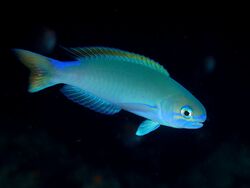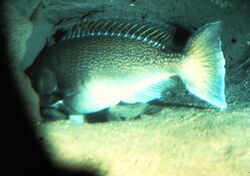Biology:Tilefish
| Tilefishes | |
|---|---|

| |
| Hoplolatilus randalli | |
| Scientific classification | |
| Script error: No such module "Taxobox ranks".: | Animalia |
| Script error: No such module "Taxobox ranks".: | Chordata |
| Script error: No such module "Taxobox ranks".: | Actinopterygii |
| Script error: No such module "Taxobox ranks".: | Perciformes |
| Script error: No such module "Taxobox ranks".: | Percoidea |
| Script error: No such module "Taxobox ranks".: | Malacanthidae |
| Subfamilies[1][2] | |
|
see text | |
| Synonyms[3] | |
|
Branchiostegidae Jordan, 1923 | |
right|250px|thumb| Blue blanquillo, ''Malacanthus latovittatus''
Tilefishes are mostly small perciform marine fish comprising the family Malacanthidae.[1][4] They are usually found in sandy areas, especially near coral reefs. They have a long life span, up to 46 years (females) and 39 years (males). [5]
Commercial fisheries exist for the largest species, making them important food fish. However, the U.S. Food and Drug Administration warns pregnant or breastfeeding women against eating tilefish and some other fish due to mercury contamination. [6][7] Exceptionally colorful smaller species of tilefish are favored for aquariums.
Taxonomic issues
The family is further divided into two subfamilies: Latilinae, sometimes called the Branchiosteginae, and Malacanthinae.[4][8] Some authors regard these subfamilies as two evolutionarily distinct families.[1][4]
The placement of this family within the Eupercaria is still uncertain. The 5th edition of Fishes of the World classifies them within the Perciformes but in a grouping of seven families that may have a relationship to Acanthuroidei, Monodactylidae, and Priacanthidae,[2] while other authorities place it outside the Perciformes, at an order level but with its true relationships being incertae sedis.[9]
Subfamilies and genera
The following two subfamilies and five genera are classified within the family Malacanthidae, in total it contains 45 species.[10][2][11][3]
- subfamily Latilinae Gill, 1862
- genus Branchiostegus Rafinesque, 1815
- genus Caulolatilus Gill, 1862
- genus Lopholatilus Goode & Bean, 1879
- subfamily Malacanthinae Poey, 1861
- genus Hoplolatilus Günther 1887
- genus Malacanthus Cuvier 1829
Description
The two subfamilies appear to be morphologically different, with members of the Latilinae having deeper bodies bearing predorsal ridge and heads rounded to squarish in profile. In contrast, members of the Malacanthinae are more slender with elongated bodies lacking predorsal ridge and rounded head. They also differ ecologically, with latilines typically occurring below 50 m and malacanthines shallower than 50 m depth.[4]
Tilefish range in size from 11 cm (4.3 in) (yellow tilefish, Hoplolatilus luteus) to 125 cm (49 in) (great northern tilefish, Lopholatilus chamaeleonticeps) and a weight of 30 kg (66 lb).[12]
Both subfamilies have long dorsal and anal fins, the latter having one or two spines. The gill covers (opercula) have one spine which may be sharp or blunt; some species also have a cutaneous ridge atop the head. The tail fin may range in shape from truncated to forked. Most species are fairly low-key in colour, commonly shades of yellow, brown, and gray.[12] Notable exceptions include three small, vibrant Hoplolatilus species: the purple sand tilefish (H. purpureus), Starck's tilefish (H. starcki), and the redback sand tilefish (H. marcosi).[13]
Tilefish larvae are notable for their elaborate spines.[1] The family name Malacanthidae, is based on the type genus Malacanthus which is a compound of the Greek words malakos meaning "soft" and akanthos meaning "thorn", possibly derived from the slender, flexible spines in the dorsal fin of Malacanthus plumieri.[10]
Habitat and diet
Generally shallow-water fish, tilefish are usually found at depths of 50–200 m in both temperate and tropical waters of the Atlantic, Pacific, and Indian Oceans. All species seek shelter in self-made burrows, caves at the bases of reefs, or piles of rock, often in canyons or at the edges of steep slopes. Either gravelly or sandy substrate may be preferred, depending on the species.[14]
Most species are strictly marine; an exception is found in the blue blanquillo (Malacanthus latovittatus) which is known to enter the brackish waters of Papua New Guinea's Goldie River.[15]
Tilefish feed primarily on small benthic invertebrates, especially crustaceans such as crab and shrimp. Mollusks, worms, sea urchins, and small fish are also taken.[16]
After the 1882 mass die-off,[17] great northern tilefish were thought to be extinct until a large number were caught in 1910 near New Bedford, Massachusetts.[18]
Behaviour and reproduction

Active fish, tilefish keep to themselves and generally stay at or near the bottom. They rely heavily on their keen eyesight to catch their prey. If approached, the fish quickly dive into their constructed retreats, often head-first. The chameleon sand tilefish (Hoplolatilus chlupatyi) relies on its remarkable ability to rapidly change colour (with a wide range) to evade predators.[19]
Many species form monogamous pairs, while some are solitary in nature (e.g., ocean whitefish, Caulolatilus princeps), and others colonial. Some species, such as the rare pastel tilefish (Hoplolatilus fronticinctus) of the Indo-Pacific, actively builds large rubble mounds above which they school and in which they live. These mounds serve as both refuge and as a microecosystem for other reef species.[13]
The reproductive habits of tilefish are not well studied. Spawning occurs throughout the spring and summer; all species are presumed not to guard their broods. Eggs are small (< 2 mm) and made buoyant by oil. The larvae are pelagic and drift until the fish have reached the juvenile stage.[13]
Timeline
The relative extant of Branchiostegus in the archeological record: <timeline> ImageSize = width:1000px height:auto barincrement:15px PlotArea = left:10px bottom:50px top:10px right:10px
Period = from:-65.5 till:10 TimeAxis = orientation:horizontal ScaleMajor = unit:year increment:5 start:-65.5 ScaleMinor = unit:year increment:1 start:-65.5 TimeAxis = orientation:hor AlignBars = justify
Colors =
#legends id:CAR value:claret id:ANK value:rgb(0.4,0.3,0.196) id:HER value:teal id:HAD value:green id:OMN value:blue id:black value:black id:white value:white id:cenozoic value:rgb(0.54,0.54,0.258) id:paleogene value:rgb(0.99,0.6,0.32) id:paleocene value:rgb(0.99,0.65,0.37) id:eocene value:rgb(0.99,0.71,0.42) id:oligocene value:rgb(0.99,0.75,0.48) id:neogene value:rgb(0.999999,0.9,0.1) id:miocene value:rgb(0.999999,0.999999,0) id:pliocene value:rgb(0.97,0.98,0.68) id:quaternary value:rgb(0.98,0.98,0.5) id:pleistocene value:rgb(0.999999,0.95,0.68) id:holocene value:rgb(0.999,0.95,0.88)
BarData=
bar:eratop bar:space bar:periodtop bar:space bar:NAM1
bar:space bar:period bar:space bar:era
PlotData=
align:center textcolor:black fontsize:M mark:(line,black) width:25 shift:(7,-4) bar:periodtop from: -65.5 till: -55.8 color:paleocene text:Paleocene from: -55.8 till: -33.9 color:eocene text:Eocene from: -33.9 till: -23.03 color:oligocene text:Oligocene from: -23.03 till: -5.332 color:miocene text:Miocene from: -5.332 till: -2.588 color:pliocene text:Plio. from: -2.588 till: -0.0117 color:pleistocene text:Pleist. from: -0.0117 till: 0 color:holocene text:H.
bar:eratop from: -65.5 till: -23.03 color:paleogene text:Paleogene from: -23.03 till: -2.588 color:neogene text:Neogene from: -2.588 till: 0 color:quaternary text:Q.
PlotData=
align:left fontsize:M mark:(line,white) width:5 anchor:till align:left
color:miocene bar:NAM1 from: -11.608 till: 0 text: Branchiostegus
PlotData=
align:center textcolor:black fontsize:M mark:(line,black) width:25
bar:period from: -65.5 till: -55.8 color:paleocene text:Paleocene from: -55.8 till: -33.9 color:eocene text:Eocene from: -33.9 till: -23.03 color:oligocene text:Oligocene from: -23.03 till: -5.332 color:miocene text:Miocene from: -5.332 till: -2.588 color:pliocene text:Plio. from: -2.588 till: -0.0117 color:pleistocene text:Pleist. from: -0.0117 till: 0 color:holocene text:H.
bar:era from: -65.5 till: -23.03 color:paleogene text:Paleogene from: -23.03 till: -2.588 color:neogene text:Neogene from: -2.588 till: 0 color:quaternary text:Q.
</timeline>
Health effects

Tilefish from the Gulf of Mexico have been shown to have high levels of mercury, and the FDA has recommended against their consumption by pregnant women.[20] Atlantic Ocean tilefish may have lower levels of mercury and may be safer to consume.[21]
Gallery
-
Great northern tilefish, Lopholatilus chamaeleonticeps
References
- ↑ 1.0 1.1 1.2 1.3 Froese, Rainer, and Daniel Pauly, eds. (2015). "Malacanthidae" in FishBase. October 2015 version.
- ↑ 2.0 2.1 2.2 Nelson, J.S.; Grande, T.C.; Wilson, M.V.H. (2016). Fishes of the World (5th ed.). Wiley. p. 456. ISBN 978-1-118-34233-6. https://sites.google.com/site/fotw5th/. Retrieved 2021-03-07.
- ↑ 3.0 3.1 Cite error: Invalid
<ref>tag; no text was provided for refs namedvdLaan-Eschmeyer-Fricke-2014 - ↑ 4.0 4.1 4.2 4.3 Nelson, J.S. (2006). Fishes of the World (4th ed.). Hoboken, NJ: John Wiley & Sons. pp. 357–358. ISBN 978-0-471-25031-9.
- ↑ "Malacanthidae". http://www.discoverlife.org/mp/20q?search=Malacanthidae.
- ↑ "Mercury Levels in Commercial Fish and Shellfish". U.S. Food and Drug Administration. 1990–2010. https://www.fda.gov/food/foodsafety/product-specificinformation/seafood/foodbornepathogenscontaminants/methylmercury/ucm115644.htm.
- ↑ Kramer, Melody Joy (17 October 2006). "Fish FAQ: What you need to know about mercury". National Public Radio News. https://www.npr.org/templates/story/story.php?storyId=6283905.
- ↑ Eschmeyer, W.N.; Fricke, R., eds (4 January 2016). "Species by family / subfamily in the Catalog of Fishes". California Academy of Sciences. http://researcharchive.calacademy.org/research/Ichthyology/catalog/SpeciesByFamily.asp.
- ↑ Betancur-R., Ricardo; Wiley, Edward O.; Arratia, Gloria; Acero, Arturo; Bailly, Nicolas; Miya, Masaki et al. (6 July 2017). "Phylogenetic classification of bony fishes". BMC Evolutionary Biology 17 (1): 162. doi:10.1186/s12862-017-0958-3. ISSN 1471-2148. PMID 28683774.
- ↑ 10.0 10.1 "Series Eupercarria (incertae sedis): Families Callanthiidae, Centerogenyidae, Dinolestidae, Dinopercidae, Emmelichthyidae, Malacanthidae, Monodactylidae, Moronidae, Parascorpididae, Sciaenidae, and Sillaginidae". Christopher Scharpf & Kenneth J. Lazara d.b.a. The ETYFish Project. 18 September 2020. https://etyfish.org/eupercaria/.
- ↑ Eschmeyer, William N.; Fricke, Ron; van der Laan, Richard, eds. "Genera in the family Malacanthidae". California Academy of Sciences. http://researcharchive.calacademy.org/research/ichthyology/catalog/fishcatget.asp?tbl=genus&family=Malacanthidae.
- ↑ 12.0 12.1 "Malacanthida". 9 March 2016. https://mexican-fish.com/tilefish-family/.
- ↑ 13.0 13.1 13.2 Schultz, Henry C., III (July 2006). "Redoing the seafloor with tile: The subfamily Malacanthinae, part I". Reefkeeping magazine (Reef Central). http://reefkeeping.com/issues/2006-07/hcs3/. Retrieved 7 March 2021.
- ↑ Baird, Troy A. (1988). "Female and male territoriality and mating system of the sand tilefish, Malacanthus plumieri". Environmental Biology of Fishes 22 (2): 101–116. doi:10.1007/BF00001541.
- ↑ Wingerter, Kenneth (2011). "Reconsidering the sand tilefishes". https://reefs.com/magazine/aquarium-fish-reconsidering-the-sand-tilefishes/.
- ↑ "Tilefish". http://gma.org/fogm/L_chamaeleonticeps.htm.
- ↑ Marsh, Robert; Petrie, Brian; Weidman, Christopher R.; Dickson, Robert R.; Loder, John W.; Hannah, Charles G. et al. (1999). "The 1882 tilefish kill – a cold event in shelf waters off the north‐eastern United States?". Fisheries Oceanography 8 (1): 39–49. doi:10.1046/j.1365-2419.1999.00092.x.
- ↑ "Tile fish reappears". The New York Times. 2 July 1910. http://nyti.ms/1rfvc9K.
- ↑ "Chameleon sand tilefish (Hoplolatilus chlupatyi)". Joe Faszl et alii d.b.a. SeaScape Studio. c. 2009. https://seascapestudio.net/reference/fish.php?id=175.
- ↑ "Fish: What pregnant women and parents should know". U.S. Food and Drug Administration. 28 September 2022. https://www.fda.gov/Food/FoodborneIllnessContaminants/Metals/ucm393070.htm.
- ↑ "Atlantic tilefish are absolved, F.D.A. advisory says ocean species low in mercury; fishermen vindicated". The East Hampton Star. http://easthamptonstar.com/Archive/3/Atlantic-Tilefish-Are-Absolved-FDA-advisory-says-ocean-species-low-mercury-fishermen-vindi.
Further reading
- Acero, A.; Franke, R. (2001). Gorgona marina: Contribución al conocimiento de una isla única (Report). Serie Publicaciones Especiales [Special publication series]. 7. INVEMAR. pp. 123–131.
- Breder, C.M. Jr. (1936). "Scientific results of the second oceanographic expedition of the Pawnee 1926". Bulletin of the Bingham Oceanographic Collection (New Haven, CT: Yale University) 2 (3): 1–56.
- Béarez, P. (1996). "Lista de los Peces Marinos del Ecuador Continental" (in es). Revista de Biología Tropical 44: 731–741.
- Castro-Aguirre, J.L.; Balart, E.F. (2002). Lozano-Vilano, M.L.. ed. Libro Jubilar en Honor al Dr. Salvador Contreras Balderas. San Nicolás de los Garza, MX: Universidad Autonoma de Nuevo León. pp. 153–170.
- Dooley, J.K. (1978). Systematics and biology of the tilefishes (Perciformes: Branchiostegidae and Malacanthidae), with descriptions of two new species (Report). U.S. National Oceanographic and Atmospheric Administration.
External links
Wikidata ☰ Q1782772 entry
 |


